Aintree Racecourse & Betting Review: Popular Events, Offers and Interesting Facts
Aintree is most famed for hosting the Grand National, the richest jump racing event in Europe and arguably the most famous horse race in the world. Situated in a quiet village just north of Liverpool in the Northwest of England, the racecourse is undoubtedly the area’s most recognisable landmark. Discover more about Aintree horse racing betting sites as we continue to the rest of the article in the sections below. Read More
| Operator | Welcome Offer | Betting on Aintree Racecourse Events | Operator Rating | Secure Link | Terms: |
|---|---|---|---|---|---|
| 1. William Hill | £30 Free Bet |
|
5.00 ★ out of 5
|
williamhill.com | Full T&Cs apply. New online customers only, min £10/€10 stake, win only, min odds 1/2, free bets paid as 3 X £10/€10, 30 day expiry, free bet/payment method/player/country restrictions apply. 18+, Play Safe, www.gambleaware.org, #ad |
| 2. Ladbrokes | £20 Free Bet |
|
4.50 ★ out of 5
|
ladbrokes.com | Full T&Cs apply. 18+ New UK+IRE customers only. PayPal and certain deposit types excluded. Min £5 bet within 14 days of account registration at min odds 1/2 = 4 x £5 free bets. Free bets valid for 4 days on sports, stake not returned, restrictions apply. |
| 3. Betvictor | Bet £10 Get £30 in Free Bets |
|
4.50 ★ out of 5
|
betvictor.com | Full T&Cs apply. 18+ New customers only. Opt in, bet £10 at odds 2.00+ within 10 days, no cashout. Get 6x £5 Free Bets, set events at odds 2.00+. 7 day bonus expiry. T&Cs apply, see below. gambleaware.org | Please Gamble Responsibly. |
Whilst the table shown above shows some of the best betting sites on the UK market when it comes to wagering on the different races staged at Aintree – top welcome offers for new players, payout prices and betting types etc – the rest of the review will take a closer look at the Racecourse itself. As well as providing some specific details about the track, we will also be looking at the other notable racing events held here and share a few facts along with some historical insights.
The Turf Itself
Aintree is widely-renowned for being one of the most challenging courses to complete. There are a total of sixteen steeplechase fences to be negotiated. Among these are the infamous Beecher’s Brook, a daunting fence with a 6ft 9 drop on the other side and an unforgiving angle that many jockeys have said feels like “jumping off the edge of the world”; The Chair; the tallest fence on the course, which is positioned right in front of the Grandstand and has a reverse effect to the Brook in that the landing on the other side is actually 15cm above ground level; and the Canal Turn, the fence famed for the preceding sharp left turn of no less 90 degrees that comes immediately after the fence has been jumped. These are just a few of the obstacles unique to this course, which more often than not, dramatically influence the outcome of the event and have led to it becoming on the most famous tracks in the world.
Most Popular Aintree Racecourse Horse Racing Events
The most popular event held at Aintree Racecourse is undoubtedly the Grand National. This event is staged during the three-day-long festival of racing known as the Aintree Festival and is second only to the Cheltenham Gold Cup in terms of its popularity among horse racing fans in the UK. The Aintree horse racing season, however, runs from October through to May and features a few other events of real worth that sit outside the April Festival window. Among these are The Old Roan Chase, a Grade 2 National Hunt steeplechase worth around £70,000 of 2miles 3 furlongs and 200yards reserved for horses aged four-years-old and above; the Becher Chase, a Grade 3 steeplechase worth around £150,000 of 3 miles 1 furlong 188 yards and reserved for slightly more mature horses aged six years and above; and the Grand Sefton Steeplechase, a race of just under three miles which has been run on the first Saturday in December in recent years.
Some Interesting Facts
Did you know that fence building for the Grand National begins approximately three weeks before the event kicks off? A remarkable 150 tonnes worth of tree branches are taken from forests in the Lake District and transported to the Aintree horse racing track so that preparation can begin. In its early years at Aintree the Grand National a solid brick wall was one of the obstacles that had to be negotiated by the riders! Rather unsurprisingly, this abandoned after five years.
| Racecourse Information: | ||||
|---|---|---|---|---|
| First Opened: | 1829 |
|
||
| Max. Race Distance: | 4m 2f 74y | |||
| Surface: | Turf | |||
| Event: | The Grand National | |||
| Average Temperature: | 6°/19° | |||
| Racecourse Capacity: | 75000 | |||
Since the unfortunate deaths of two horses in the 2011 Grand National there has been a concerted effort to try and improve the safety of the course and enhance animal welfare. A few fences were redesigned by replacing certain materials at the core in order to make them less dangerous. The 3rd and 11th fences on the Grand National course that had previously been open ditches were redesigned to have birch at the core. Similarly, the last two fences on the second lap of the course now have plastic birch at the core rather than the uncompromising timber frames that had been used in the past that were said to have contributed to some of the accidents. These changes have, in turn, led to Aintree Racecourse betting becoming even more popular.
Aintree Racecourse: The Story so Far
The Aintree Racecourse was first opened in 1829 after Mr William Lynn, owner of the Waterloo Hotel in Liverpool, leased a sizeable plot of land from one Lord Sefton. A course was then built along with a grandstand in 1836 and a series of different races, including a number of flat races, were staged. Originally, Lynn only wanted to stage three meetings per year on the course, however, the popularity of events held during the first few years inspired him to introduce a memorable steeplechase. The first Grand National was held 10 years after the racecourse opened and was then called The Grand Liverpool Steeplechase. Since then, Aintree horse racing betting has never been the same.
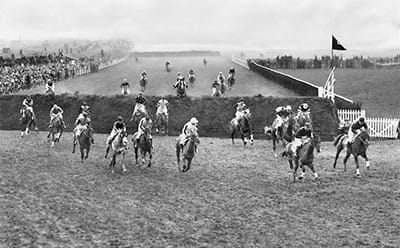 An vintage shot of Aintree
An vintage shot of Aintree
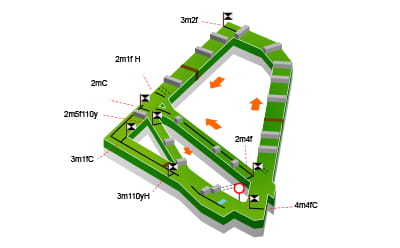 Aintree Racecourse map
Aintree Racecourse map
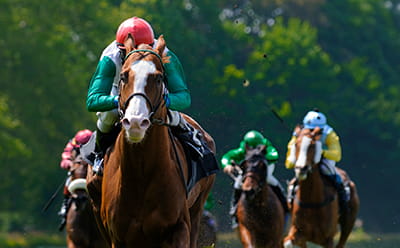 A modern day race at Aintree
A modern day race at Aintree
During the periods of the First and Second World Wars races at the Aintree Racecourse horse racing track, including the Grand National, was abandoned. In the postwar years, however, the track slowly recovered, and in recent times solidified its status as one of the most-loved and prestigious tracks in the British Isles. As previously mentioned, the track has undergone a number of changes as to ensure the safety of the horses and riders competing in the different races held there. The Jockey Club (the owner of the racecourse) has expressed its commitment to continue carrying out whatever measures necessary to uphold its status as a leading racecourse.
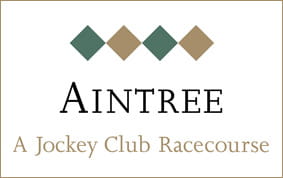 Aintree Racecourse logo
Aintree Racecourse logo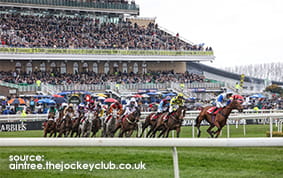 The Grandstand at Aintree Racecourse
The Grandstand at Aintree Racecourse